Thermal Performance of Novel Eco-Friendly Prefabricated Walls for Thermal Comfort in Temperate Climates
Abstract
:1. Introduction
2. Materials and Methods
2.1. Climatic Characterization
2.2. Prefabricated Eco-Friendly Channels and Experimental Prototypes
2.3. Evaluation of the Thermal Performance of Experimental Prototypes
2.4. Evaluation of the Equivalent Thermal Conductivity
3. Results
3.1. Climate Characterization
3.2. Thermal Performance of Housing Prototypes
4. Discussion
Relevance and Significance of the Current Study
5. Conclusions
Author Contributions
Funding
Institutional Review Board Statement
Informed Consent Statement
Data Availability Statement
Acknowledgments
Conflicts of Interest
References
- Tsitoura, M.; Michailidou, M.; Tsoutsos, T. A Bioclimatic Outdoor Design Tool in Urban Open Space Design. Energy Build. 2017, 153, 368–381. [Google Scholar] [CrossRef]
- Frank, A.A.; Kuchen, E. Validación de La Herramienta Metodológica de Alonso-Frank & Kuchen Para Determinar El Indicador de Nivel de Eficiencia Energética Del Usuario de Un Edificio Residencial En Altura, En San Juan—Argentina. Rev. Hábitat Sustentable 2017, 7, 6–13. [Google Scholar]
- Manzano-Agugliaro, F.; Montoya, F.G.; Sabio-Ortega, A.; García-Cruz, A. Review of Bioclimatic Architecture Strategies for Achieving Thermal Comfort. Renew. Sustain. Energy Rev. 2015, 49, 736–755. [Google Scholar] [CrossRef]
- Wegertseder, P.; Schmidt, D.; Hatt, T.; Saelzer, G.; Hempel, R. Barreras y Oportunidades Observadas En La Incorporación de Estándares de Alta Eficiencia Energética En La Vivienda Social Chilena. Arquit. Urban. 2014, 35, 37–49. [Google Scholar]
- ISO7730:2005; Ergonomics of the Thermal Environment-Analytical Determination and Interpretation of Thermal Comfort Using Calculation of the PMV and PPD Indices and Local Thermal Comfort Criteria. International Organization for Standardization: Geneva, Switzerland, 2005.
- ANSI/ASHRAE 55:2004; Thermal Environmental Conditions for Human Occupancy. ASHRAE: Peachtree Corners, GA, USA, 2004.
- Maldonado, E.; Yannas, S.; Gonçalves, H. Studies of the Thermal Performance of Buildings in Summer in Southern Europe. Int. J. Sol. Energy 1997, 19, 161–178. [Google Scholar] [CrossRef]
- Czajkowski, J.D.; Gómez, A.F.; Gracia Bianciotto, M. Comportamiento Térmico de Viviendas Sociales Mediante Incorporación de Mejoras de Diseño En La Envolvente. Av. Energírenov. Medio Ambiente 2008, 12, 33–40. [Google Scholar]
- Youcef Ettoumi, F.; Messen, N.; Adane, A.E.H.; Sauvageot, H. Temperature Variations in a Housing of the Semi-Arid Region of Djelfa (Algeria). Build. Environ. 2003, 38, 511–519. [Google Scholar] [CrossRef]
- Karlsson, J.; Wadsö, L.; Öberg, M. A Conceptual Model That Simulates the Influence of Thermal Inertia in Building Structures. Energy Build. 2013, 60, 146–151. [Google Scholar] [CrossRef]
- Alavéz-Ramírez, R.; Chiñas-Castillo, F.; Morales-Domínguez, V.J.; Ortiz-Guzmán, M.; Caballero-Montes, J.L.; Caballero-Caballero, M. Thermal Lag and Decrement Factor of Constructive Component Reinforced Mortar Channels Filled with Soil–Cement–Sawdust. Indoor Built Environ. 2018, 27, 466–485. [Google Scholar] [CrossRef]
- Filippín, C.; Flores Larsen, S. Comportamiento Termico de Verano de Viviendas Unifamiliares Compactas En Condiciones Reales de Uso En Clima Templado En Argentina. Av. Energías Renov. Medio Ambient. 2010, 14, 1–8. [Google Scholar]
- Flores, L.S.; Flores Larsen, S.; Filippín, C. Comportamiento Térmico de Invierno y Verano de Viviendas de Interes Social En La Provincia de Salta. Av. Energías Renov. Medio Ambient. 2007, 11, 167–173. [Google Scholar]
- Gallegos-Ortega, R.; Magaña-Guzmán, T.; Reyes-López, J.A.; Romero-Hernández, M.S. Thermal Behavior of a Straw Bale Building from Data Obtained in Situ. A Case in Northwestern México. Build. Environ. 2017, 124, 336–341. [Google Scholar] [CrossRef]
- Medjelakh, D.; Abdou, S. Impact de l’inertie Thermique Sur Le Confort Hygrothermique et La Consommation Énergétique Du Bâtiment. Rev. Des Energies Renouvelables 2008, 11, 329–341. [Google Scholar] [CrossRef]
- Norén, A.; Akander, J.; Isfält, E.; Söderström, O. The Effect of Thermal Inertia on Energy Requirement in a Swedish Building—Results Obtained with Three Calculation Models. Int. J. Low Energy Sustain. Build. 1999, 1, 1–16. [Google Scholar]
- Shaviv, E.; Yezioro, A.; Capeluto, I.G. Thermal Mass and Night Ventilation as Passive Cooling Design Strategy. Renew. Energy 2001, 24, 445–452. [Google Scholar] [CrossRef]
- Givoni, B. Effectiveness of Mass and Night Ventilation in Lowering the Indoor Daytime Temperatures. Part I: 1993 Experimental Periods. Energy Build. 1998, 28, 25–32. [Google Scholar] [CrossRef]
- Ogoli, D.M. Predicting Indoor Temperatures in Closed Buildings with High Thermal Mass. Energy Build. 2003, 35, 851–862. [Google Scholar] [CrossRef]
- Aste, N.; Angelotti, A.; Buzzetti, M. The Influence of the External Walls Thermal Inertia on the Energy Performance of Well Insulated Buildings. Energy Build. 2009, 41, 1181–1187. [Google Scholar] [CrossRef]
- Filippín, C.; Flores Larsen, S.; Flores, L. Comportamiento Energetico de Verano de Una Vivienda Masica y Una Liviana En La Region Central de Argentina. Av. Energías Renov. Medio Ambient. 2007, 11, 17–23. [Google Scholar]
- Fuentes Freixanet, V. Mapas Bioclimáticos de La República Mexicana, 1st ed.; Universidad Autόnoma Metropolitana: México City, Mexico, 2014. [Google Scholar]
- SMN Normales Climatológicas, Comisión Nacional Del Agua. Available online: https://smn.conagua.gob.mx/tools/RESOURCES/Normales_Climatologicas/Normales9120/oax/nor9120_20079.txt (accessed on 26 October 2024).
- Bahar, R.; Benazzoug, M.; Kenai, S. Performance of Compacted Cement-Stabilised Soil. Cem. Concr. Compos. 2004, 26, 811–820. [Google Scholar] [CrossRef]
- Roseto, O. Bloques Con Mezclas Hipercomprimidas de Suelo-Cemento. Rev. Cem. 1996, 6, 11–13. [Google Scholar]
- NMX-C-037-ONNCCE; Building Industry Concrete, Blocks, Bricks or Partition Masonry Wits Units Determination of Absorbent Water and Determination of Initial Absorbent. Industria de la construcciOn-Bloques: San Francisco, CA, USA, 2005.
- Auliciems, A.; Szokolay, S.V. Thermal Comfort, 2nd ed.; PLEA NOTE 3 Passive and Low Energy Architecture International: Chapel Hill, Australia, 1985; ISBN 0-86776-729-4. [Google Scholar]
- Szokolay, S.V. Introduction to Architectural Science: The Basis of Sustainable Design, 2nd ed.; Elsevier Ltd.: Oxford, UK, 2008; ISBN 0-7506-58495. [Google Scholar]
- Meteotest Meteonorm. Global Meteorological Database for Engineers, Planners and Education; Edition 2020 Software and Data Cd-Rom; Meteonorm: Bern, Switzerland, 2020. [Google Scholar]
- De Dear, R.; Brager, G.S. The Adaptive Model of Thermal Comfort and Energy Conservation in the Built Environment. Int. J. Biometeorol. 2001, 45, 100–108. [Google Scholar] [CrossRef] [PubMed]
- Olgyay, V. Design with Climate: Bioclimatic Approach to Architectural Regionalism: New and Expanded Edition, 2016th ed.; Princeton University Press: Princeton, NJ, USA, 2015; ISBN 9781400873685. [Google Scholar]
- Evans, J.M.; de Schiller, S. Diseño Bioambiental y Arquitectura Solar., 3rd ed.; FADU, UBA, Buenos Aires, Argentina: Buenos Aires, Argentina, 1994; ISBN 950-29-0037-5. [Google Scholar]
- Huelsz, G.; Barrios, G.; Rechtman, R.; Rojas, J. Importancia Del Análisis de Transferencia de Calor Dependiente Del Tiempo En La Evaluación Del Desempeño Térmico de La Envolvente de Una Edificación. Estud. Arquit. Bioclimática 2011, 9, 9–19. [Google Scholar]
- Varini, C. Ecoenvolventes: Entre Continuidad e Innovacion, 1st ed.; Universidad Piloto de Colombia: Bogota, Colombia, 2016; ISBN 9789588957364. [Google Scholar]
- De Garrido, L. Manual de Arquitectura Ecológica Avanzada, 1st ed.; Ediciones de la U: Bogota, Colombia, 2017; ISBN 9789587627053. [Google Scholar]
- Belhadj, B.; Bederina, M.; Makhloufi, Z.; Goullieux, A.; Quéneudec, M. Study of the Thermal Performances of an Exterior Wall of Barley Straw Sand Concrete in an Arid Environment. Energy Build. 2015, 87, 166–175. [Google Scholar] [CrossRef]
- Roux-Gutiérrez, R.S.; Velázquez Lozano, J. Bloques de Tierra Comprimida, Su Retardo Térmico e Impacto Ambiental. Rev. Legado Arquit. Diseño 2016, 19, 81–90. [Google Scholar]
- De Ignacio Vivens, G.; Soutullo Castro, S.; López-Zaldivar, O.; Lozano-Diez, R.V.; Verdú Vázquez, A. Sobre Inercia Térmica y Aislamiento de Viviendas En Clima Cálido-Húmedo = On Thermal Inertia and Insulation of Buildings in Warm-Humid Climate. An. Edif. 2018, 4, 14–26. [Google Scholar] [CrossRef]
- Ulgen, K. Experimental and Theoretical Investigation of Effects of Wall’s Thermophysical Properties on Time Lag and Decrement Factor. Energy Build. 2002, 34, 273–278. [Google Scholar] [CrossRef]
- Alavéz-Ramírez, R.; Chiñas-Castillo, F.; Caballero-Caballero, M.; Juventino Morales-Domínguez, V.; Ortiz-Guzmán, M.; Eugenia Silva-Rivera, M.; Candido Jimenez-Piñon, R.; Ramos-Alonso, A. Sugar Cane Products as a Sustainable Construction Material—Case Study: Thermophysical Properties of a Corncob and Cane Bagasse Ash Panel. In Sugarcane—Its Products and Sustainability; Kumar Ghimire, B., Ed.; IntechOpen: London, UK, 2023; pp. 1–22. ISBN 978-1-80356-369-5. [Google Scholar]
- Roux Gutierrez, R.S.; Gallegos Sanchez, D.P. Construccion Sustentable, Analisis de Retraso Termico a Bloques de Tierra Comprimidos. Context. Rev. Fac. Arquit. Univ. Autónoma Nuevo León 2015, 9, 59–71. [Google Scholar]
- Bevilacqua, P.; Mazzeo, D.; Arcuri, N. Thermal Inertia Assessment of an Experimental Extensive Green Roof in Summer Conditions. Build. Environ. 2018, 131, 264–276. [Google Scholar] [CrossRef]
- Balaji, N.C.; Mani, M.; Venkatarama Reddy, B.V. Thermal Performance of the Building Walls. Build. Simul. Appl. 2013, 346, 151–159. [Google Scholar]
- Ozel, M.; Ozel, C. Comparison of Thermal Performance of Different Wall Structures. In Proceedings of the HEFAT2012 9th International Conference on Heat Transfer, Fluid Mechanics and Thermodynamics, Hefat, Malta, 16–18 July 2012; pp. 674–679. [Google Scholar]
- Humaish, H.; Marmoret, L.; Beji, H. Effect of Thermal Inertia (Time Lag and Decrement Factor) on the Insulation Thermal Capacity. In Proceedings of the 2018 International Conference on Advance of Sustainable Engineering and its Application (ICASEA), Wasit-Kut, Iraq, 14–15 March 2018; pp. 137–141. [Google Scholar] [CrossRef]
- Asan, H.; Sancaktar, Y.S. Effects of Wall’s Thermophysical Properties on Time Lag and Decrement Factor. Energy Build. 1998, 28, 159–166. [Google Scholar] [CrossRef]
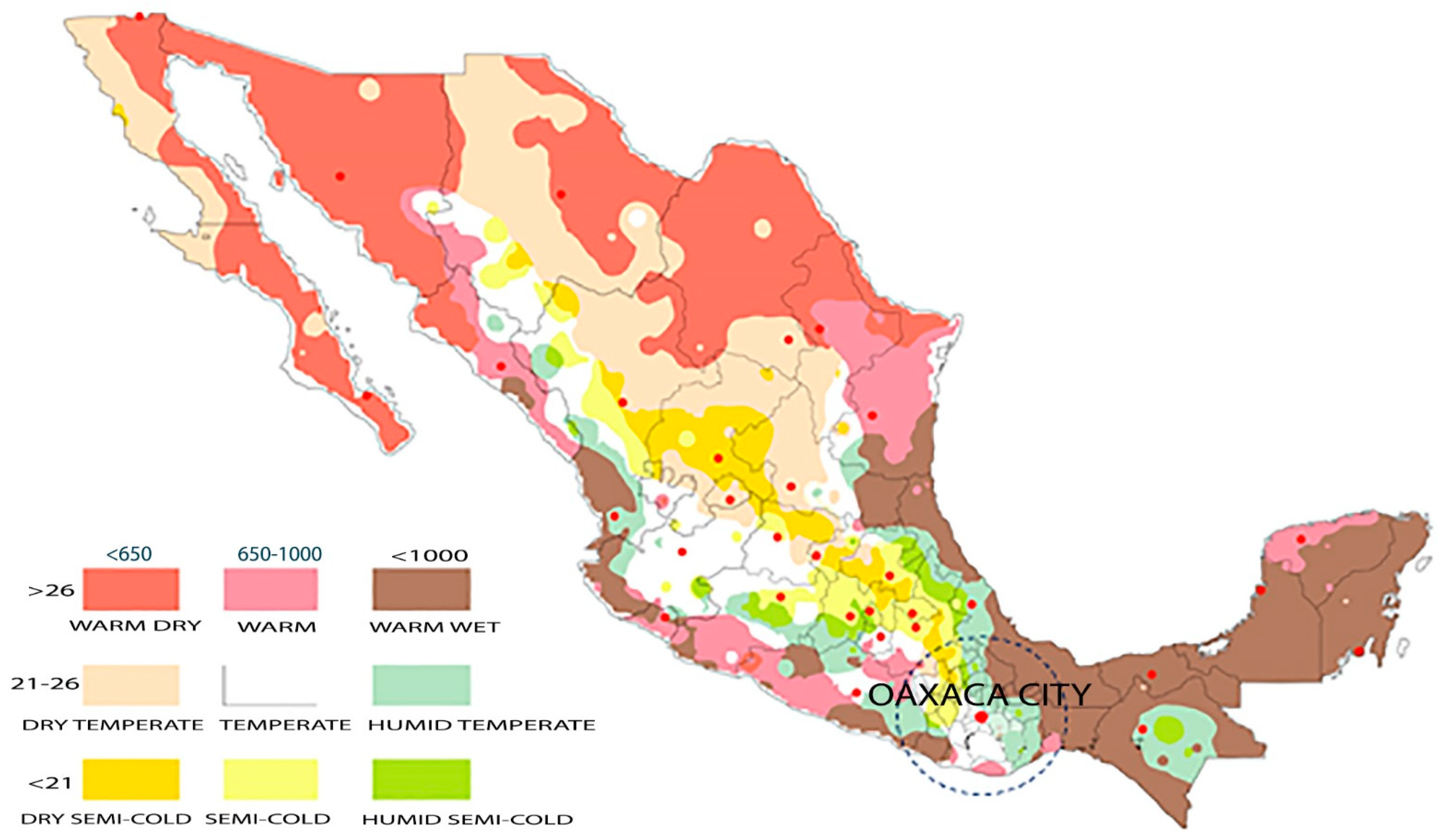



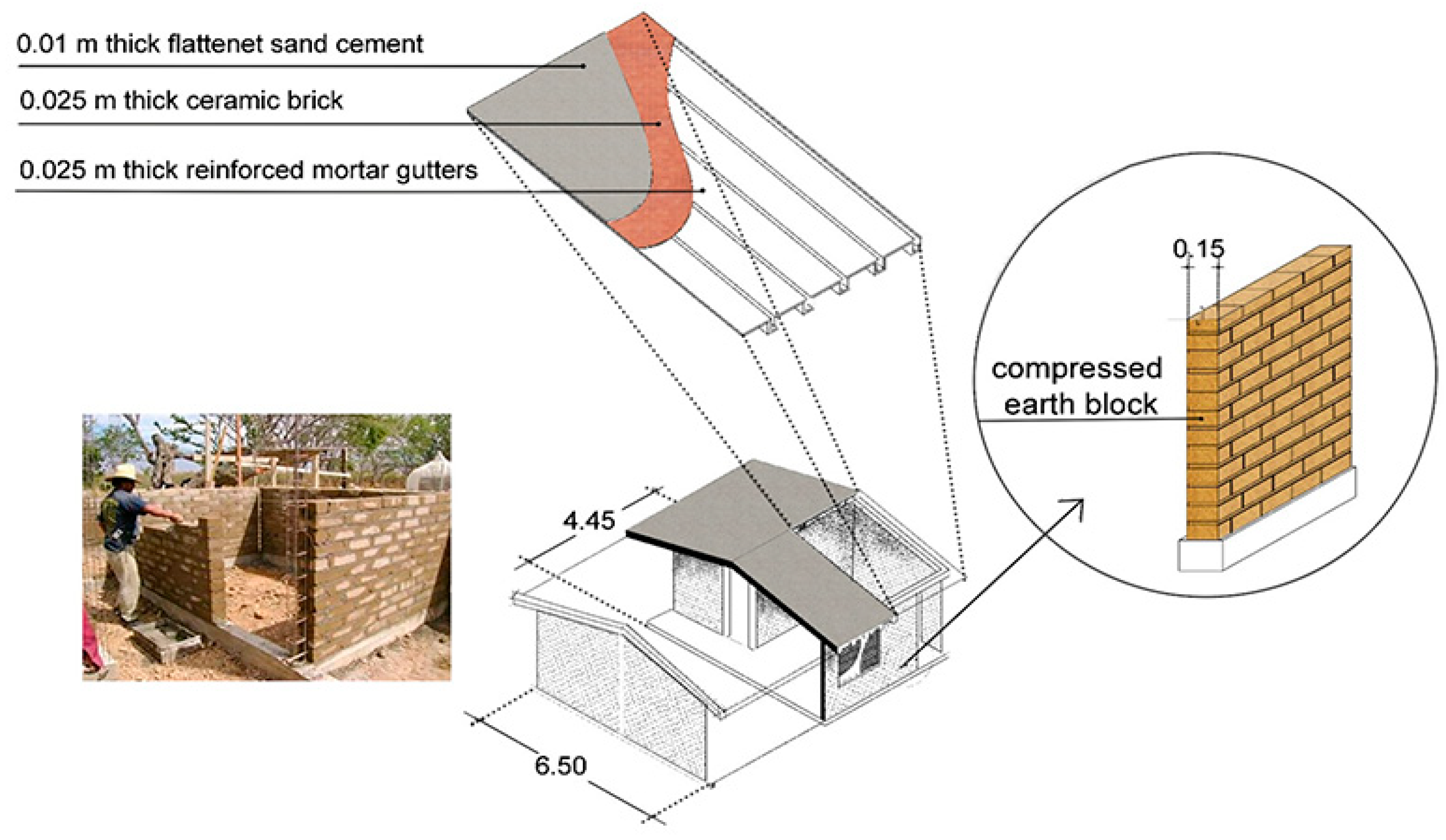


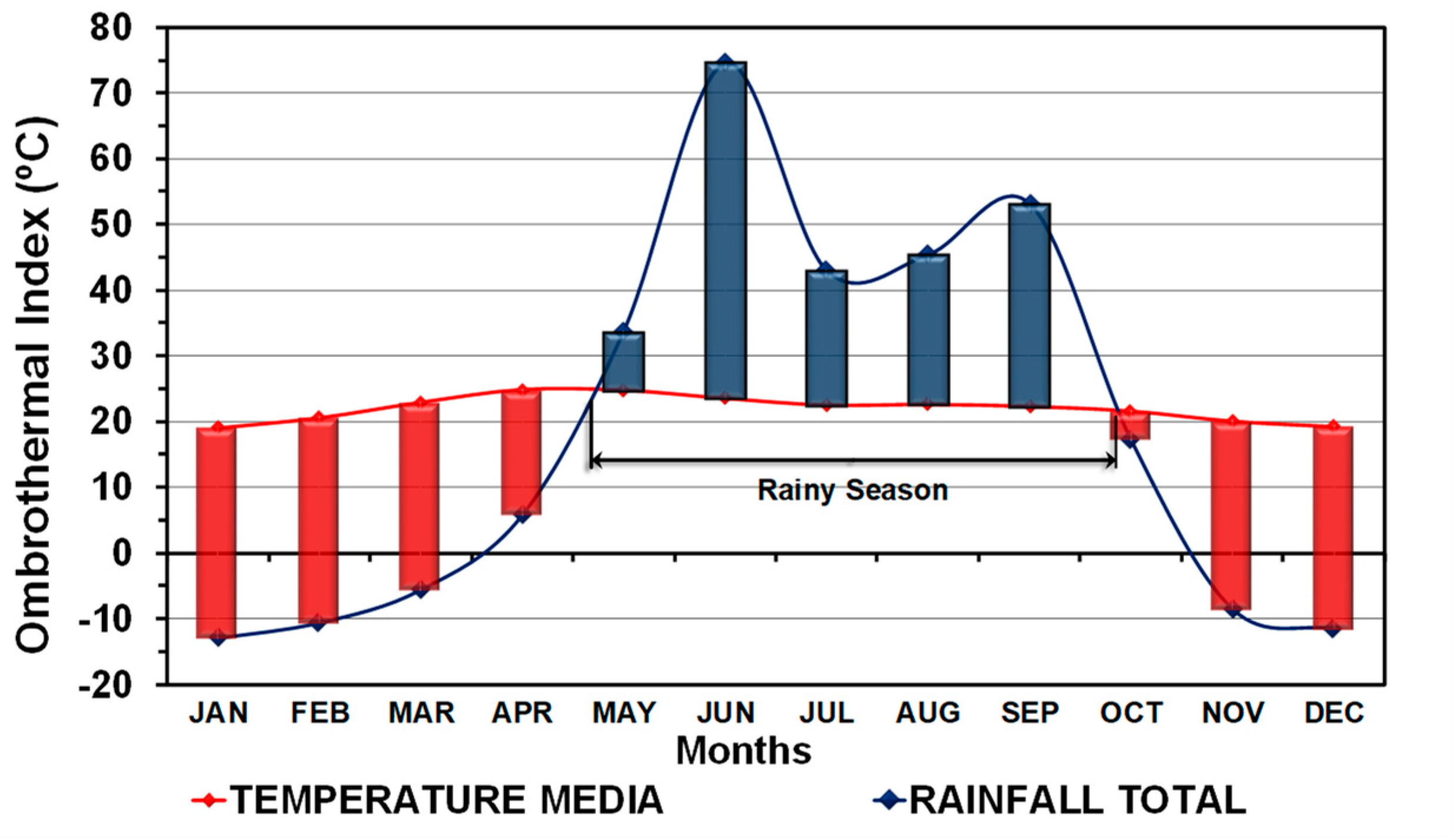
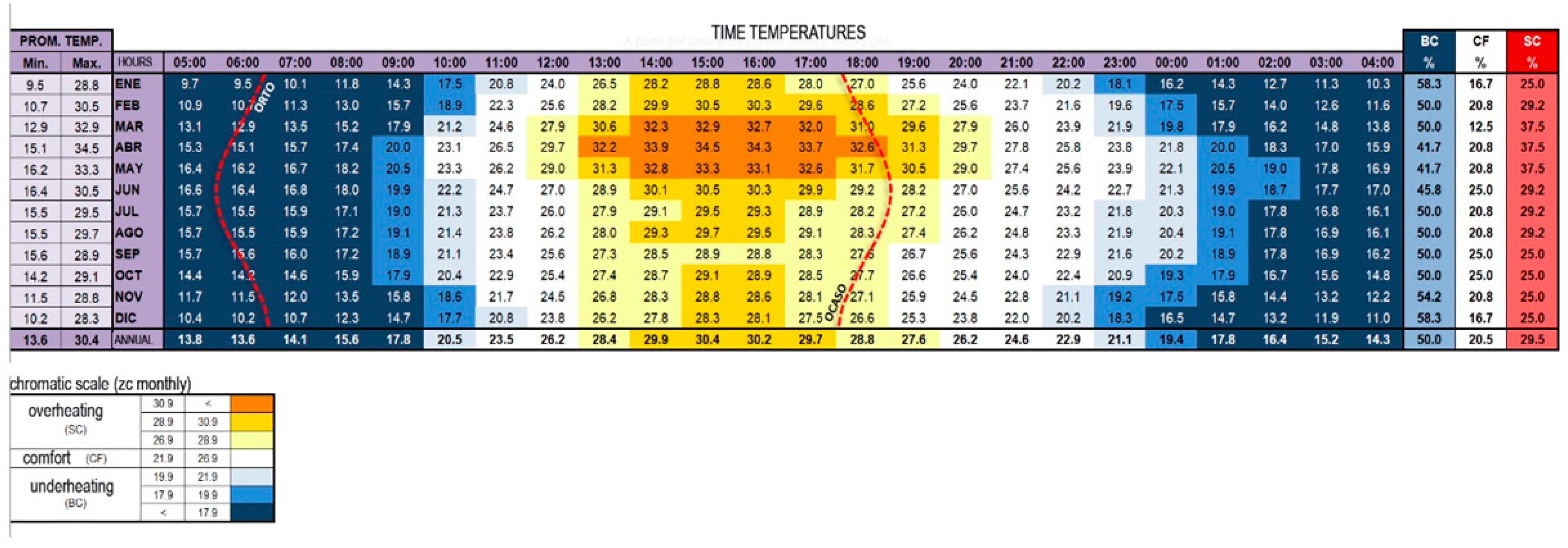

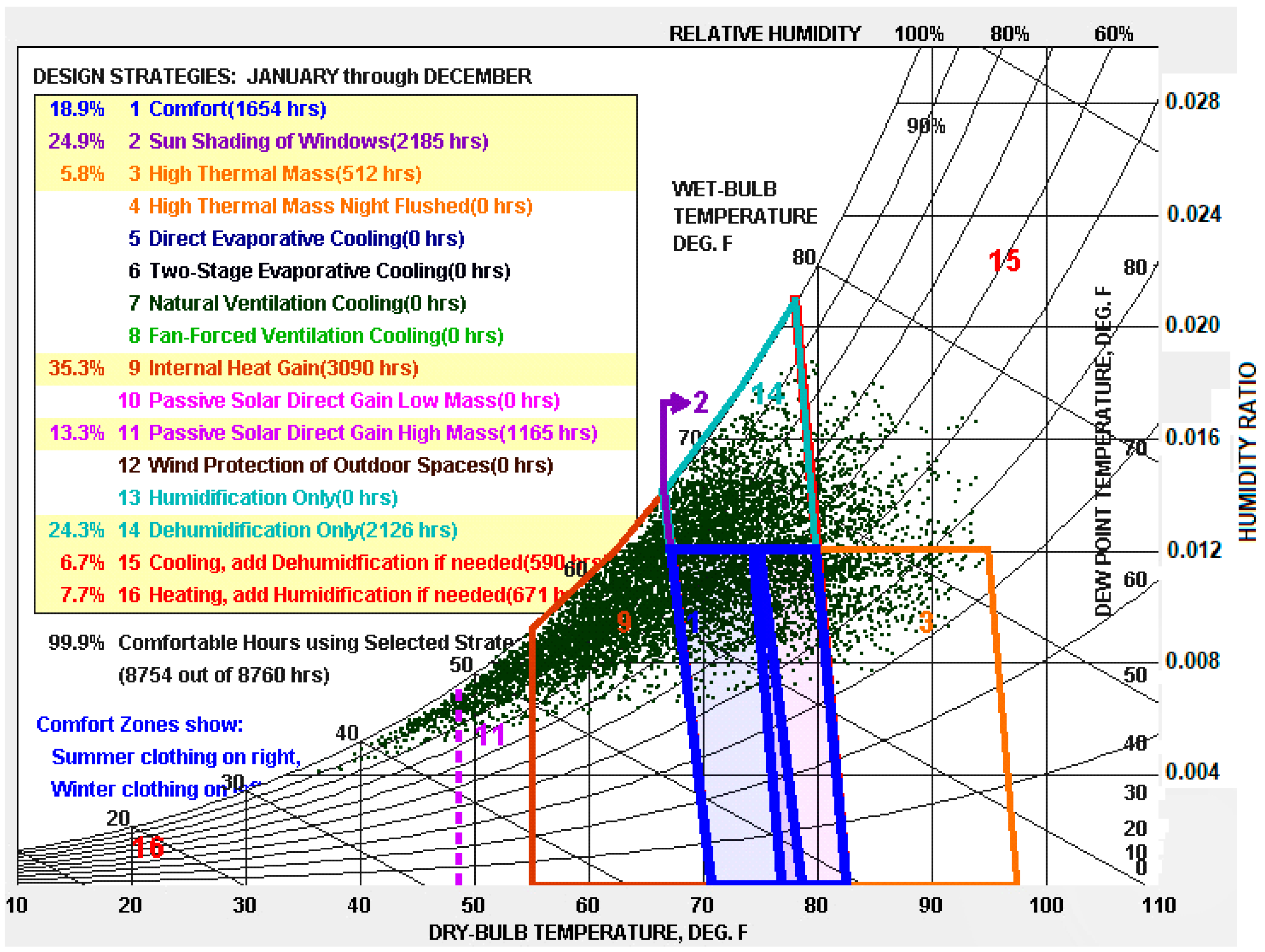
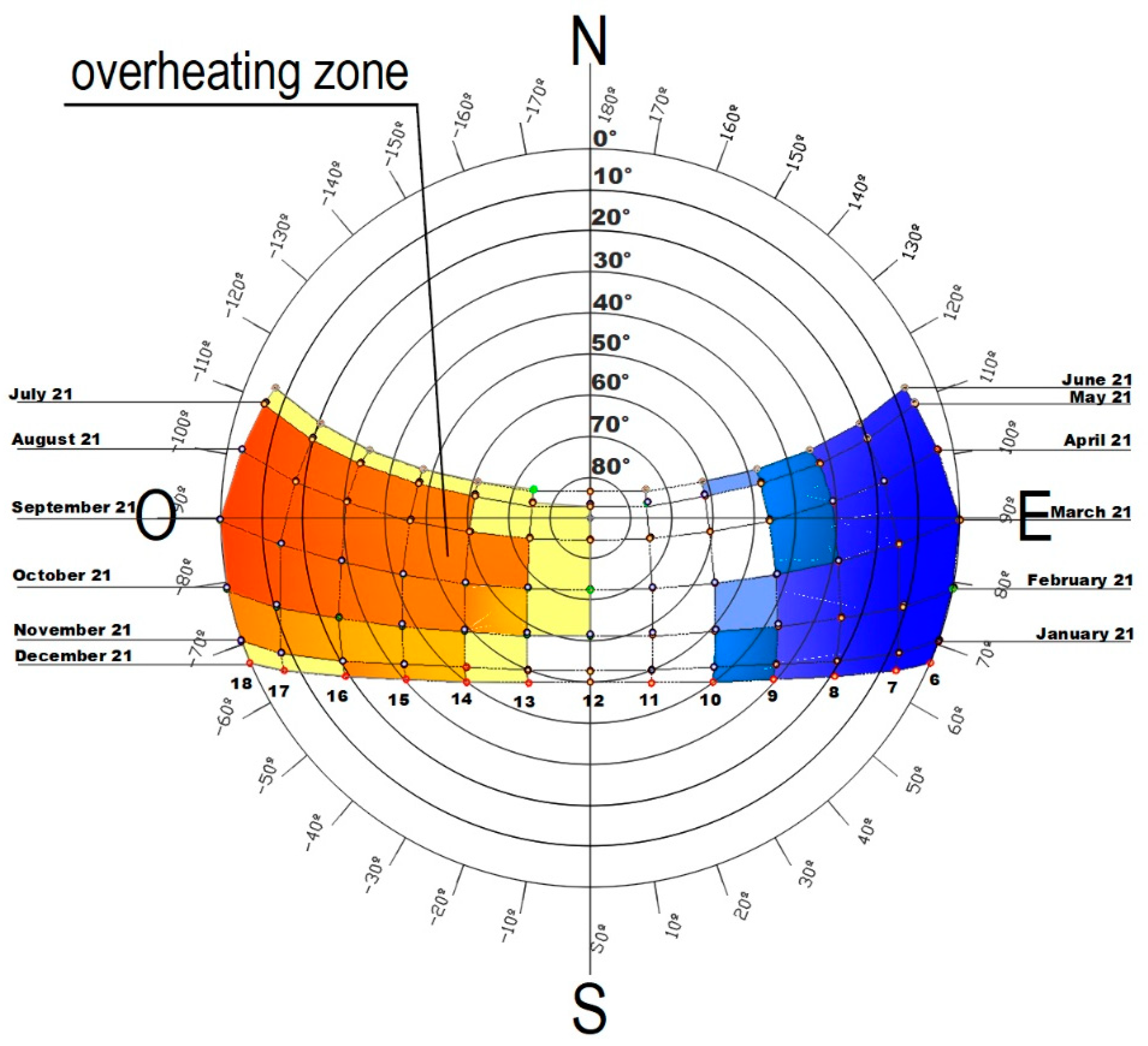
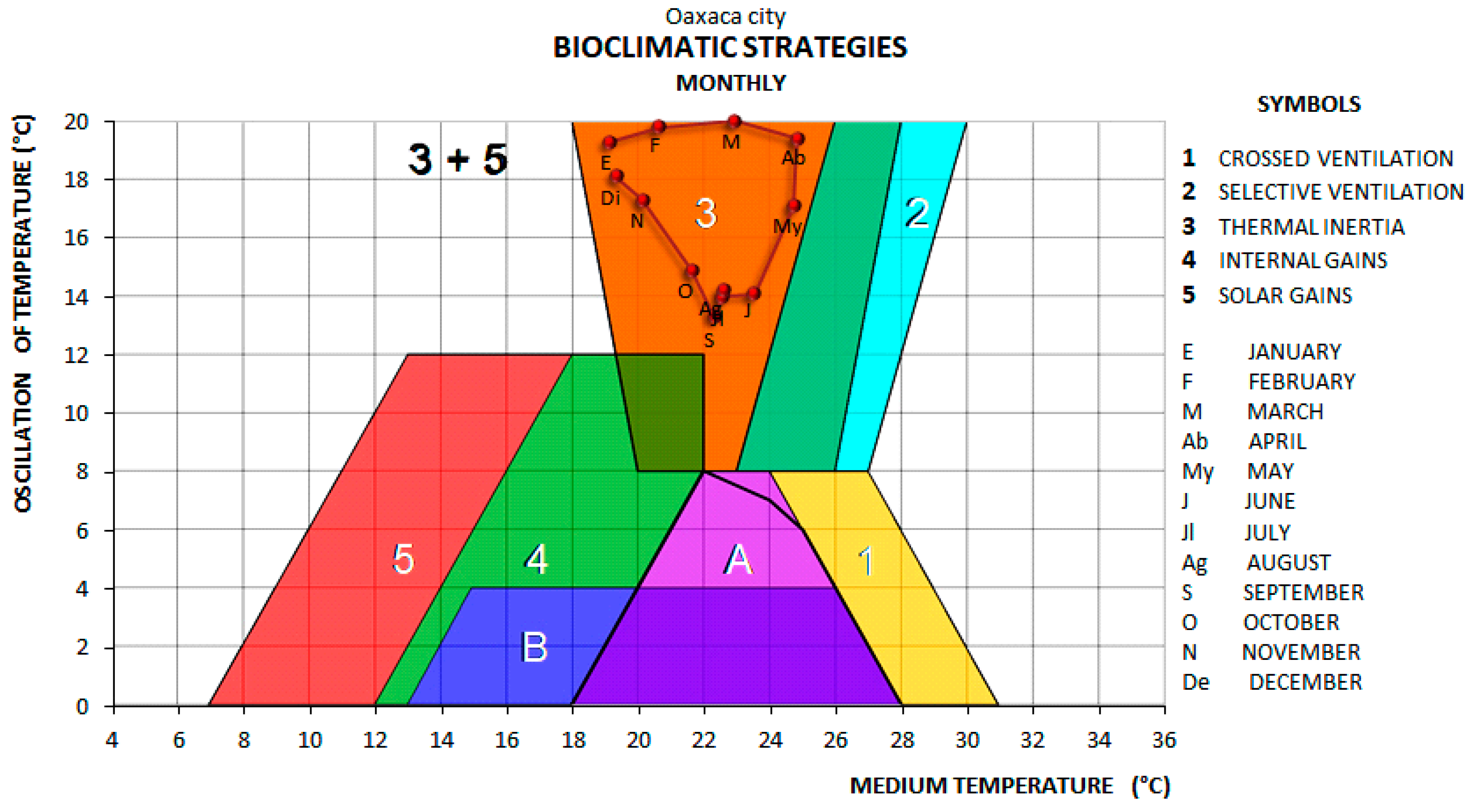
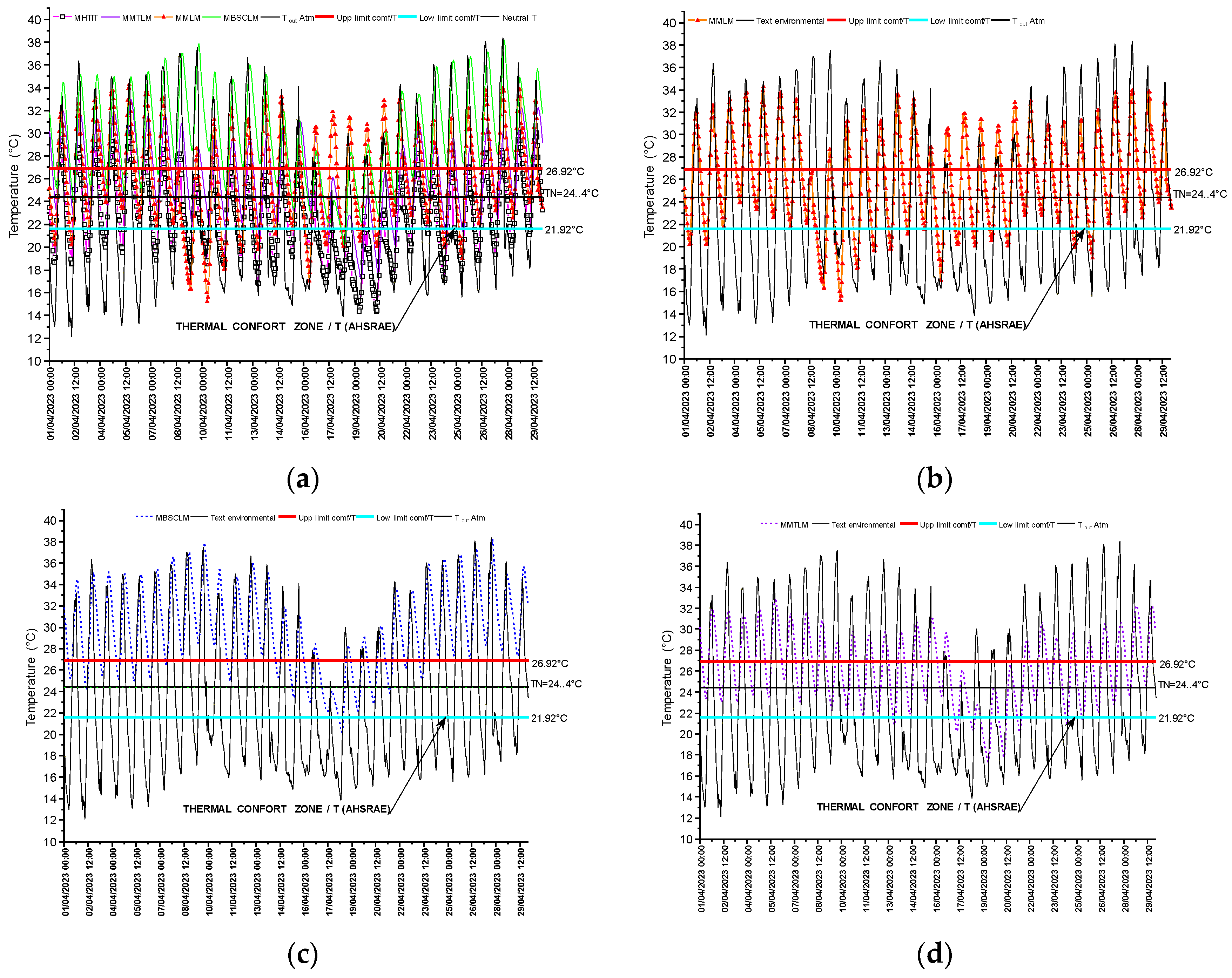





| AVERAGE | |||||
| Variable | N | R² | R² Aj | CV | |
| Average | 118 | 0.2 | 0.17 | 3.51 | |
| Analysis of Variance Table (SC type III) | |||||
| F.V. | SC | gl | CM | F | p-valor |
| Model | 20.19 | 5 | 4.04 | 5.67 | 0.0001 |
| Prototype | 20.19 | 5 | 4.04 | 5.67 | 0.0001 |
| Error | 79.76 | 112 | 0.71 | ||
| Total | 99.95 | 117 | |||
| Test: Tukey Alfa = 0.05 DMS = 0.80224, Error: 0.7121 gl: 112 | |||||
| PROTOTYPE | Median | n | E.E. | Comparison | |
| MMTLM | 24.57 | 18 | 0.2 | A | |
| MBSCLM | 24.27 | 24 | 0.17 | A | |
| MMLM | 24.14 | 21 | 0.18 | A | |
| MHTIT | 24.01 | 19 | 0.19 | A | B |
| Outside Temperature | 23.82 | 12 | 0.24 | A | B |
| MHTITCA | 23.3 | 24 | 0.17 | B | |
| Median values with a common letter are not significantly different (p > 0.05). | |||||
| Constructive System | Underheat (%) | Comfort (%) | Overheat (%) |
|---|---|---|---|
| MMLM | 14 | 44 | 42 |
| MBSCLM | 1 | 23 | 76 |
| MMTLM | 8 | 48 | 44 |
| MHTIT | 14 | 45 | 41 |
| MHTITCA | 15 | 85 | 0 |
| System | Outside Surface Temperature Average Day in April | Inside Surface Temperature Average Day in April | Decrement Factor | ||||
|---|---|---|---|---|---|---|---|
| Temp | Temp | ∆t Outside | Temp | Temp | ∆t Inside | ||
| Max (°C) | Min (°C) | surface | Max (°C) | Min (°) | surface | ||
| MHTITCA | 34.78 | 17.06 | 17.72 | 22.3 | 20.36 | 1.94 | 0.109 |
| Prototype | ∆TIn | ∆Tout | Decrement Factor |
|---|---|---|---|
| MHTITCA | 1.94 | 17.72 | 0.109 |
| MHTIT | 8.46 | 0.477 | |
| MBSCLM | 8.12 | 0.458 | |
| MMTLM | 7.54 | 0.425 | |
| MMLM | 13.09 | 0.738 |
| Part | λ (W/m K) | TC (W/m2 K) | C (J/K) ×106 | Y (W/m2·K) | α (m2·s−1) ×10−6 | β (J·m−2·K−1·s−0.5) | ρ (kg/m3) | Ms (kg/m3) | L (m) |
|---|---|---|---|---|---|---|---|---|---|
| MHTITCA | 0.28 | 1.08 | 0.068 | 1.08 | 1.098 | 271.81 | 1285.38 | 340.625 | 0.265 |
| Wall Type | Thermal Lag (H) | Decrement Factor | References |
|---|---|---|---|
| Component of reinforced mortar channel filled with cement–soil (18 cm thick) | 7.5 | 0.16 | [40] |
| MHTITCA real-scale house prototype prefabricated channel of reinforced mortar filled with soil–sawdust fiber–cement combined with insulation (20.5 cm thick) | 12 | 0.109 | This work |
| Simple compressed earth block with plaster (16.5 cm thick) | 1.5 | 1.807 | [41] |
| Double compressed earth block (BTC) with plaster (30.5 cm thick) | 4.25 | 2.162 | [41] |
| Baked clay brick (14 cm thick) | 0.5 | 1.561 | [41] |
| Concrete block (14 cm thick) | 0.5 | 1.886 | [41] |
| Extensive green roof (29 cm thick) | 8.5 | 0.098 | [42] |
| Brick wall with plaster on both sides plus polyurethane insulation on the outside (33 cm thick) | 12.275 | 0.009 | [43] |
| Cellular concrete (15 cm thick) | 4.837 | 0.104 | [43] |
| Dense concrete (15 cm thick) | 2.512 | 0.488 | [43] |
| Concrete with plaster on both sides (24 cm) with expanded polystyrene insulation (5 cm), total thickness of 29 cm | 7.04 | 0.0157 | [44] |
| Straw and cement walls with thicknesses of 10 to 25 cm | 4 to 8 | 0.15 a 0.85 | [36] |
| Straw bale walls 40 cm thick | 9 | Not reported | [14] |
Disclaimer/Publisher’s Note: The statements, opinions and data contained in all publications are solely those of the individual author(s) and contributor(s) and not of MDPI and/or the editor(s). MDPI and/or the editor(s) disclaim responsibility for any injury to people or property resulting from any ideas, methods, instructions or products referred to in the content. |
© 2024 by the authors. Licensee MDPI, Basel, Switzerland. This article is an open access article distributed under the terms and conditions of the Creative Commons Attribution (CC BY) license (https://creativecommons.org/licenses/by/4.0/).
Share and Cite
Alavez-Ramirez, R.; Chiñas-Castillo, F.; Martínez-Reyes, J.; Caballero-Montes, J.L.; Caballero-Caballero, M.; Morales-Dominguez, V.J.; Ortiz-Guzman, M.; Robledo-Taboada, L.H.; Juarez-Arellano, E.A.; Serrano-De la Rosa, L.E. Thermal Performance of Novel Eco-Friendly Prefabricated Walls for Thermal Comfort in Temperate Climates. Sustainability 2024, 16, 9349. https://doi.org/10.3390/su16219349
Alavez-Ramirez R, Chiñas-Castillo F, Martínez-Reyes J, Caballero-Montes JL, Caballero-Caballero M, Morales-Dominguez VJ, Ortiz-Guzman M, Robledo-Taboada LH, Juarez-Arellano EA, Serrano-De la Rosa LE. Thermal Performance of Novel Eco-Friendly Prefabricated Walls for Thermal Comfort in Temperate Climates. Sustainability. 2024; 16(21):9349. https://doi.org/10.3390/su16219349
Chicago/Turabian StyleAlavez-Ramirez, Rafael, Fernando Chiñas-Castillo, Jacobo Martínez-Reyes, Jose Luis Caballero-Montes, Magdaleno Caballero-Caballero, Valentin Juventino Morales-Dominguez, Margarito Ortiz-Guzman, Luis Humberto Robledo-Taboada, Erick Adrian Juarez-Arellano, and Laura Elvira Serrano-De la Rosa. 2024. "Thermal Performance of Novel Eco-Friendly Prefabricated Walls for Thermal Comfort in Temperate Climates" Sustainability 16, no. 21: 9349. https://doi.org/10.3390/su16219349
APA StyleAlavez-Ramirez, R., Chiñas-Castillo, F., Martínez-Reyes, J., Caballero-Montes, J. L., Caballero-Caballero, M., Morales-Dominguez, V. J., Ortiz-Guzman, M., Robledo-Taboada, L. H., Juarez-Arellano, E. A., & Serrano-De la Rosa, L. E. (2024). Thermal Performance of Novel Eco-Friendly Prefabricated Walls for Thermal Comfort in Temperate Climates. Sustainability, 16(21), 9349. https://doi.org/10.3390/su16219349









